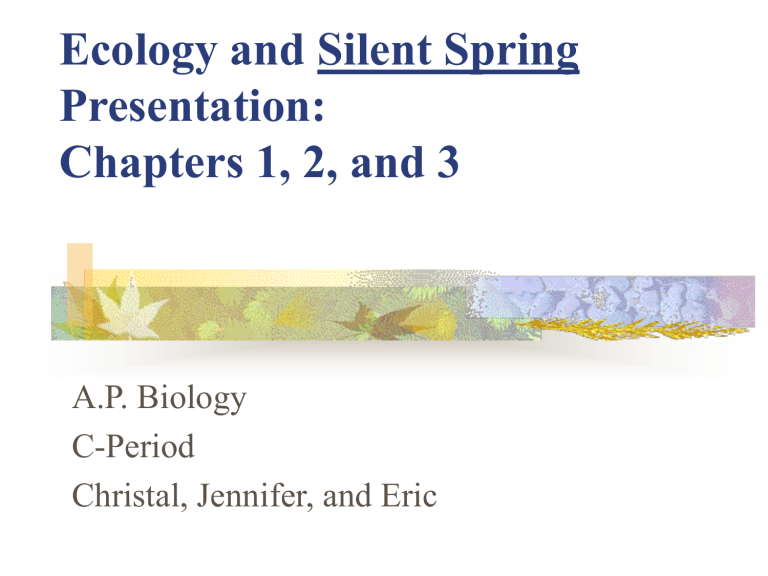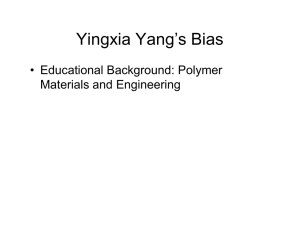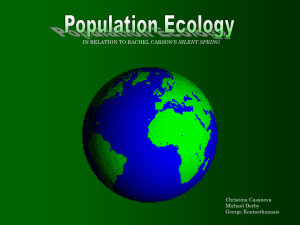Ecology and Silent Spring Presentation: Chapters 1, 2, and 3 A.P. Biology

Ecology and Silent Spring
Presentation:
Chapters 1, 2, and 3
A.P. Biology
C-Period
Christal, Jennifer, and Eric
Introduction
Rachel Carson begins her book, Silent Spring, describing a typical, American environment filled with various plants and animals.
Disease and death spreading is suddenly introduced, affecting all life.
Through this book she tries to answer “what has already silenced the voices of spring in countless towns in
America?”
Silent Spring reveals the effects of chemical poisoning on our environment, and has raised the society’s current awareness of environmental issues.
“Obligation to Endure”
The environment has molded Earth’s physical form, habitats, vegetation, animal life, ect.
Only man has had the power to alter the world.
An example is the civilian use of insecticides that has lead to the increase of pollution.
People need to learn and understand the effects of this chemical. The reason?
Everything on earth, living things and their surroundings, must interact with one another to survive.
This means that every organisms and environment everywhere has been contaminated.
Deadly DDT
Although many chemicals were mentioned, DDT was referred to a lot.
DDT is a hydrocarbon known as dicholoro – diphenyl – tricholoro, commonly found in pesticides during the time the book was published.
Although seemly harmless, with no immediate ill effects, the chemical can be stored and accumulated in fat.
This is deadly because organisms rely on their fat reservoirs when food is not available.
This may become more frequent because the use of pesticides is killing most resources of food.
Spreading the Chemical
Since organisms can store DDT, the poison can also be passed through each trophic level in a food chain.
As each organism is eaten, it not only gives energy, but also passes the chemicals it had stored.
Although the energy available is lessened as a food chain progresses, the higher the trophic level, the higher the concentration of DDT is passed.
This means that organisms at the top of the food chains, the predators, are affected and die, leaving prey unchecked in nature.
This causes an imbalance; the prey may grow profusely and become “pests.”
How Chemicals Mix with Other in Nature
Another deadly effect occurs when hydrocarbons, such as
DDT, are mixed and react with other chemicals.
For example, a freshwater ecosystem has an abundant amount of nitrogen, which often stimulates the growing of phytoplankton.
The great amount of carbon stored in DDT may cause a negative reaction with the nitrogen.
This may severely affect the growth and survival rate of the phytoplankton, thus affecting the predators that feed on them and the entire food web of the ecosystem.
Darwin’s Theory
The use of chemicals is useless and may lead to worsen the problem at hand and cause more damage.
Often destructive insects “flareback” or have a resurgence after being sprayed.
“Survival of the fittest” – they adapt to the poisons.
People then make even deadlier poisons, and the insects again will keep becoming immune, ect.
The introduction of these synthetic chemicals forces all organisms, including man, to adjust to about 500 new chemicals a year.
Most chemicals are synthetic and have no natural counterpart to balance it out.
The same is true for species introduced in an environment with no natural enemies.
The transplant of elm trees created an unnatural distribution of the trees in one area that provided more habitats and resources for beetles.
This caused the beetles to overpopulate the area and become pests.
Sometimes the new species may even take over the original inhabitant through competition.
If they compete for the same resources, habits, and most importantly ecological roles (niches), one must evolve or become extinct.
No two species can share a niche in the same area.
Exposure to Chemicals Cause Genetic Mutations
Changes in body processes occur.
For example: Chemicals can break down protective enzymes. In the Nervous System, enzyme cholinesterase destroys buildup of transmitter acetylcholine. Without this enzyme, nerve impulses would be continuous, causing the animal or organism to suffer from convulsions and eventually die.
Animals have become infertile or have reproduced offspring with low mortality rates.
This causes the ecosystem to shift from high birth rates and high death rates to low birth rates and low death rates. This pattern is called demographic transition.
Populations are already limited by other factors:
Limited resources
Competition for territory and Crowding
Predators
Spread of disease
Chemicals not only accumulate in an environment and eventually poisons its habitants, but also worsen these limitation.
This makes survival even harder to accomplish.
Conclusion
As Rachel Carson says “Thus the chemical war is never won and all life is caught in its violent crossfire.”
It is our responsibility to follow the precautionary principle.
“Look before you leap!”
We must make an effort to balance and understand nature before we tamper it with chemical poisoning.






